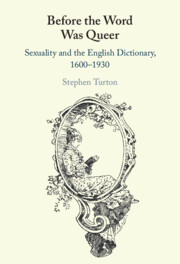Book contents
1 - Legislating Acts
The Limits of Buggery, Sodomy, and Copulation
Published online by Cambridge University Press: 14 March 2024
Summary
This chapter introduces some of the dominant institutional structures through which sexuality in Britain was interpreted. It surveys the relationship between lexicography and the law via buggery and sodomy, perhaps the words most familiarly associated with same-sex intercourse in pre-1900 English. The chapter defamiliarizes them by comparing the diverse explanations given to them across hard-word and general dictionaries, law lexicons, and legal treatises. Lexicographers constructed buggery and sodomy as crimes beyond the bounds of human law, as well as the natural and divine laws on which it was meant to be based; in so doing, they also built for their readers a contrastive model of lawful erotic behaviour. However, the scaffolding of sexual normativity was unstable. Dictionaries ascribed conflicting polysemies to buggery and sodomy, which were variably said to include ‘copulation’ between men, between women, between woman and man ‘unnaturally’, or between man or woman and beast. At the same time, buggery and sodomy were often rendered not only illegal but incoherent, as cross-sex-specific definitions of copulation itself precluded the possibility of same-sex activity.
- Type
- Chapter
- Information
- Before the Word Was QueerSexuality and the English Dictionary, 1600–1930, pp. 30 - 55Publisher: Cambridge University PressPrint publication year: 2024

